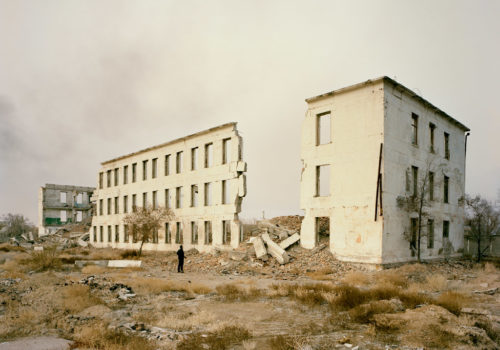Desolation can muster a swarm of anxiety. The associations of destruction are both literal and subconscious. The hands of human experimentation inexorably alter the state of a landscape and our planet.
Those actions are unalterably timeless.
Nadav Kander’s new body of work, and book, DUST, study one such place. In Russia there is a closed atomic city Kurchatov, a closed military city Priorzersk, and the Aral Sea where the effects of human choices silently stretch like poisonous fingers. The state and scope of the land is telling; the treatment Kander’s eye gives is aesthetic and keen. His intrigue is one of beauty and decay.
Not to sound archaic or nihilistic, all things move towards a state of entropy. This march is associated with a sense of The End, a poor representation of a much more eager and exciting process. What comes after? That’s the mystery. There’s proof of what in Kander’s photos. There’s not a death or an end; there’s a lack of order and predictabilities thrown out. What was becomes flat and broad in the tundra of these hidden Russian locations. Buildings, things, places, all with original intentions have been destroyed. In their isolation they have evolved.
These landscapes portray duress and defect. Through camera and treatment certain secrets reveal an endured history. Kander ennobles that photographic mission. The empty shells of architecture in the images enact with the nature of the land. They are mending. Kander continually stresses to me the ticking of his Geiger counter; a necessary trinket that was always with him while photographing. The tax of people on these test sites has bred an unthinkable dystopia. It is unimaginably photogenic. Beyond words, simply put, the imagery is absolutely beautiful in it’s abashed sublimity.
There is something inexorably toxic about the light; it is without forgiveness, cooling in the clouds a sort of acid fluorescent green. These photos are not looked at; they brood at you. There is something removed – there’s just got to be – even if it’s only a ruse or something poetic. Gray is no longer the enemy of art, nor is dust. Dust, a thing so reviled in an art space. The ash of Kander’s imagery is momentous in its monstrous reflection of the place’s history. There is no policy but there is geography – vertical – springing pieces growing through the snow and brush like new buds.
The juxtaposition between collapse and resurrection is important. Does the landscape give up, or does it give in? The weight and catalyst of these emotions can teach us what we are looking at. The photos allow the narrative to be inside the viewer. They are heavy and eager to upset, however, they are not without reward.
EXPOSITION
DUST
Nadav Kander
From April 7th to May 7th, 2016
Flowers Gallery
529 West 20th Street
New York NY 10011
United States
T: +(1) 212 439 1700
http://www.flowersgallery.com
















